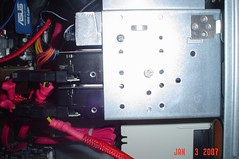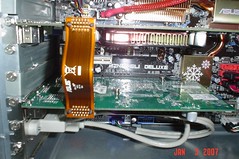In an earlier post here, I provided the specs to my new system that I built during my 1 week sebatical before starting my new job.
 Well, in just over a month, I've already upgraded.
Well, in just over a month, I've already upgraded.
| "I ordered two idential 250GB WD drives and configured them in RAID 1 mode (mirroring)." |
Yep, its true.
While at first, my inner geek was pleased with my new rig- with a dual core processor and 2 GB of schaweet DDR2 RAM- how could it get much better?
Well, I will 'splain.
First, after tooling around on my new machine, I quickly realized that while a 400 GB hardrive is mondo big and would provide for enough storage to allow me to do all the video editing I could imagine as well as keep me from having to uninstall old games to reinstall new ones, it was impractical. The reason being that while 400GB is very accomodating, it also becomes incresingly volitile as the capacity fills up. From a risk perspective, anything above and beyond game files would just be a liability in the event of a HD crash. Sure, I could back up the 400GB monster, but to what media? Another 400GB (or better) monster, just sitting there, under-utilized?
So what did I do? You guessed it! I dropped another $160 and got a second 400GB drive!  No, not exactly. For about $60 more than I paid for the Seagate drive, I ordered two idential 250GB WD drives and configured them in RAID 1 mode (mirroring). This should be perfect for gaming, video editing and development, especially since I have a 120 GB external USB 2.0 drive also installed for the purpose of staging video and content before it goes to production. The mirroring will provide 100% fault tolerance in the event that one of the disks goes bad. Although it is possible that both disks could fail at once, this possibility is purely theoretical. Today, RAID is becoming a staple in mid-range to high-end machines and with disk prices this cheap, there really isn't a good reason not to protect your data.
No, not exactly. For about $60 more than I paid for the Seagate drive, I ordered two idential 250GB WD drives and configured them in RAID 1 mode (mirroring). This should be perfect for gaming, video editing and development, especially since I have a 120 GB external USB 2.0 drive also installed for the purpose of staging video and content before it goes to production. The mirroring will provide 100% fault tolerance in the event that one of the disks goes bad. Although it is possible that both disks could fail at once, this possibility is purely theoretical. Today, RAID is becoming a staple in mid-range to high-end machines and with disk prices this cheap, there really isn't a good reason not to protect your data.
The second addition was completely unexpected. While Asus' flagship AM2 board comes SLI ready, I wasn't sure that I'd be adding a second card anytime real soon. For anyone that is unaware and curious,  SLI stands for Scalable Link Interface. It is a technology developed by Nividia that allows for two cards to be bound together as a single output. Essentially, this is the equivelent of dual processors on a board, which is similar in concept to dual core, where both processors reside on the same processor wafer. Well, during one of my almost weekly visits to Fry's, I caught the week's add circular which stated a whopping $80 mail in rebate and a $30 instant rebate on eVGA Geforce 7600GT cards! A pefect pair to my existing eVGA Geforce 7600GT card for 70 bucks?! Deal! So, my system is now in SLI mode with two eVGA Geforce 7600GT cards. I can't wait to run some benchies.
SLI stands for Scalable Link Interface. It is a technology developed by Nividia that allows for two cards to be bound together as a single output. Essentially, this is the equivelent of dual processors on a board, which is similar in concept to dual core, where both processors reside on the same processor wafer. Well, during one of my almost weekly visits to Fry's, I caught the week's add circular which stated a whopping $80 mail in rebate and a $30 instant rebate on eVGA Geforce 7600GT cards! A pefect pair to my existing eVGA Geforce 7600GT card for 70 bucks?! Deal! So, my system is now in SLI mode with two eVGA Geforce 7600GT cards. I can't wait to run some benchies.
On a side note, one of the rules I adopted some time ago with regard to video cards is to never, ever buy the latest spec.  Chances are, as I have several times before, you'll get burned. New technlogy is completely expendable, and when you are paying for the latest spec, you are going to overpay because the minute you pop that card into your new rig, you will read about the next big thing which will immediately devalue your investment. Regardless of what zealots may say, there is more to dropping $250 to $300 on a card than the mere fun and satisfaction that comes with enjoying the card as soon as you get it home. It is painful to see the card drop $100 two months later forever relegated to the obsolete bin. So my rule is to try to buy last year's hot card. In this case, back in 2005 it was the Geforce 7600GT chips that was hot. Now, as you can see, I can pick up a second card for $70- I only wish my first card would have been that cheap!
Chances are, as I have several times before, you'll get burned. New technlogy is completely expendable, and when you are paying for the latest spec, you are going to overpay because the minute you pop that card into your new rig, you will read about the next big thing which will immediately devalue your investment. Regardless of what zealots may say, there is more to dropping $250 to $300 on a card than the mere fun and satisfaction that comes with enjoying the card as soon as you get it home. It is painful to see the card drop $100 two months later forever relegated to the obsolete bin. So my rule is to try to buy last year's hot card. In this case, back in 2005 it was the Geforce 7600GT chips that was hot. Now, as you can see, I can pick up a second card for $70- I only wish my first card would have been that cheap!
So, all said and done, here are the revised specs of my new build:
Englight Midtower Case (This thing is built like a tank. I've owned it since 2001!)
HIPER HPU-4S580-MS ATX12V 580W Power Supply
ASUS M2N32-SLI Deluxe
AMD X2 3800+ (AM2 Socket)
Corsair XMS2 2Gb Dual Kit @ DDR2-800
2 eVGA Geforce 7600GT in SLI Dual Mode
Plextor PX-716SA DVD/CD RW Optical drive
Sony 24X CD-R Optial drive
2 Western Digitial Caviar 250 GB SATA Hardrives in RAID 1 (Mirroring)
CPU-Z Specs
(Click to Enlarge)
|

CPU
|

Motherboard
|
|

Memory
|

Memory SPD
|